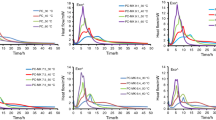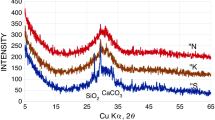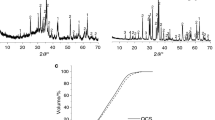Abstract
Isothermal conduction calorimetry, differential thermal analysis (DTA)–thermogravimetric analysis (TG) analysis, and SEM observations have proved the activation effect of Ca(OH)2 released from the C3S hydration upon blast furnace slag (BFS). Five sample mixtures of BFS and C3S and two samples of pure BFS and C3S were submitted to reaction with water inside the calorimeter at room temperature. The values of hydration heat were recorded up to 7 days. Samples were stored in humidity during 28 days and then were submitted to DTA–TG and SEM analysis. The effect of Ca(OH)2 upon heat evolution of sample mixtures has been quantified and its influence upon the formation of new hydrates and microstructure of pastes was evidenced.


















Similar content being viewed by others
References
Hewlett PC. Lea′s chemistry of cement and concrete, 4th ed. St. Edmunsbury Press; 1998.
Roy DM. Alkali-activated cements, opportunities and challenges. Cem Concr Res. 1999;29:249–54.
Kourounis S, Tsivilis S, Tsakiridis PE, Papadimitriou GD, Tsibouki Z. Properties and hydration of blended cements with steelmaking slag. Cem Concr Res. 2007;37:815–22.
Xuequan W, Hong Z, Xinkai H, Husen L. Study on the steel slag and fly ash composite cement. Cem Concr Res. 1999;29:1103–6.
Ballim Y, Graham PC. Early-age heat evolution of clinker cement in relation to microstructure and composition: implications for temperature development in large concrete elements. Cem Concr Compos. 2004;26:417–26.
Doval M, Palou M, Mojumdar SC. Hydration behavior of C2S and C2AS nanomaterials, synthesized by sol-gel method. J Therm Anal Calorim. 2006;86:595–9.
Palou M, Majling J. Hydraulic activity of C4A3 \( \overline{Cr} \) in presence of C4A3 \( \overline{S}.\) J Therm Anal Calorim. 2003;71:367–73.
Palou MT, Majling J. Effects of sulfate, calcium and aluminium ions upon the hydration of sulphoaluminate belite cement. J Therm Anal. 1996;46:549–56.
Palou MT, Majling J. Hydration in the system C4A3 \( \overline{S} \)-C\( \overline{S} \)-CH–H. J Therm Anal. 1996;46:557–63.
Smrčková E, Palou MT, Tomková V. Application of conduction calorimeter for study of the reactivity of C2S in the system C2S–C4A3 \( \overline{S} \)-H. J Therm Anal. 1996;46:597–605.
Wadsö L, Smith ALS, Shirazi H, Mulligan SR. The isothermal heat conduction calorimeter: a versatile instrument for studying the processes in physics, chemistry and biology. J Chem Educ. 2001;78:1080–6.
Brandštetr J, Polcer J, Krátký J, Holešinský R, Havlica J. Possibilities of the use of isoperobolic calorimetry for assessing the hydration behaviors of cementitious materials. Cem Concr Res. 2001;31:941–7.
Lin F, Meyer C. Hydration kinetics modelling of Portland cement considering the effect of temperature and applied pressure. Cem Concr Res. 2009;39:255–65.
Kada-Benameur H, Wirquin E, Duthoit B. Determination of apparent activation energy of concrete by isothermal calorimetry. Cem Concr Res. 2000;30:301–5.
Huanhai Z, Xuequan W, Zhongzi X, Mingshu T. Kinetic study on alkali-activated slag. Cem Concr Res. 1993;23:1253–8.
Pane I, Hansen W. Investigation of blended cement hydration by isothermal calorimetry and thermal analysis. Cem Concr Res. 2005;35:1155–64.
Xu Q, Stark J. Early hydration of ordinary Portland cement with an alkaline shotcrete accelerator. Adv Cem Res. 2005;17:1–8.
Mertens G, Snellings R, Van Balen K, Bice-Smsir B, Vrlooy P, Elsen J. Pozzolanic reactions of common natural zeolites with lime and parameters affecting their reactivity. Cem Concr Res. 2009;39:233–40.
Codina M, Cau-dit-Coumes C, Le Bescop P, Verdier J, Ollivier JP. Design and characterisation of low-heat and low-alkalinity cements. Cem Concr Res. 2008;38:437–48.
Kuzielová E, Kovár V, Palou M. Thermal stability of Li2O–SiO2–CaO–P2O5–F glass. J Therm Anal Calorim. 2008;94(3):849–52.
Méducin F, Bresson B, Lequeux N, Noëlle de Noirfontaine M, Zanni H. Calcium silicate hydrates investigated by solid-state high resolution 1H and 29Si nuclear magnetic resonance. Cem Concr Res. 2007;37:631–8.
Kumar S, Kumar R, Bandopadhyay A, Alex TC, Kumar BR, Das SK, Mehrotra SP. Mechanical activation of granulated blast furnace slag and its effect on the properties and structure of Portland slag cement. Cem Concr Res. 2008;30:679–85.
Pérez-Ramíez J, Abellò S. Thermal decomposition of hydrotalcite-like compounds studied by a novel tapered element oscillating microbalance (TEOM) comparison with TG and DTA. Thermochemica Acta. 2006;444:75–82.
Acknowledgements
The authors wish to express their thanks to Scientific Grant Agency of the Ministry of Education of Slovak Republic and the Slovak Academy of Sciences VEGA 1/0571/08.
Author information
Authors and Affiliations
Corresponding author
Additional information
Cement chemistry nomenclature and abbreviations used through this article: C = CaO, S = SiO2, A = Al2O3, F = Fe2O3, CC = CaCO3, H = H2O, CH = Ca(OH)2.
Rights and permissions
About this article
Cite this article
Ježo, L., Palou, M., Kozánková, J. et al. Determination of activation effect of Ca(OH)2 upon the hydration of BFS and related heat by isothermal calorimeter. J Therm Anal Calorim 101, 585–593 (2010). https://doi.org/10.1007/s10973-010-0849-y
Published:
Issue Date:
DOI: https://doi.org/10.1007/s10973-010-0849-y




